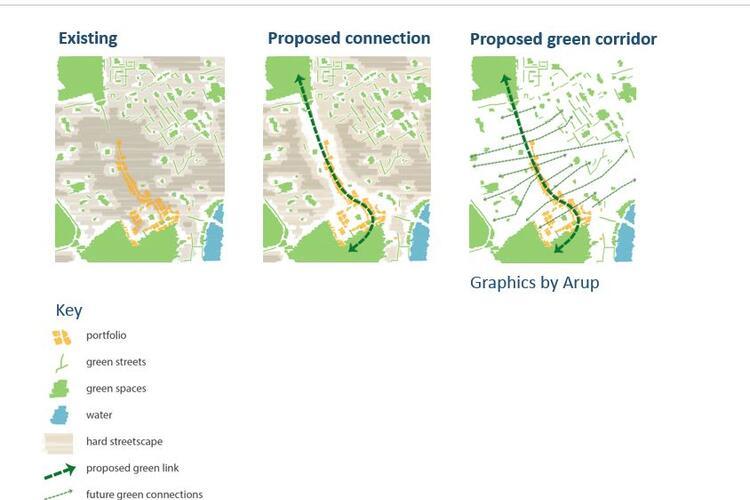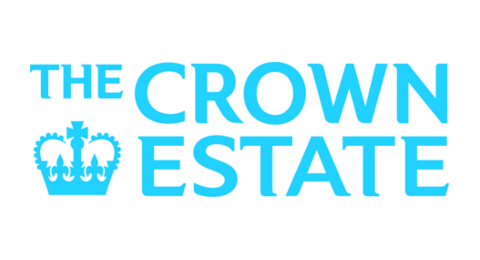Ecological Master Plan in London
07 September 2015Ecological Master Plan in London
07 September 2015As part of The Crown Estate’s ecological master plan for its holdings in Regent Street and St James’s, the organisation is creating a green corridor linking Regent's Park and St James's Park. Plans include green roofs, brown roofs, green walls, pocket habitats, community gardens, street trees, window boxes and planters, as well as bird boxes, bat boxes and bee hives. Through its estate-wide approach, The Crown Estate is creating valuable habitats for wildlife and improving the experience for people living, working and visiting the area. It will also kick start the 'Wild West End’, a unique collaboration by London property owners to promote green infrastructure in the capital, supported by the Mayor of London, the London Wildlife Trust and Arup.
Key Facts
- Creating over a hectare of new green space
- Nurturing urban biodiversity
- Improving wellbeing and air quality
- Creating more attractive environments
- Reducing heat island effect
- Increasing storm water retention
- Enhancing asset value
Situation
The Crown Estate is guided by its values in everything it does – commercialism, integrity and stewardship. For centuries, The Crown Estate has owned and carefully managed almost all of London’s Regent Street and around half of St James’s. To the north of The Crown Estate’s Central London portfolio lies Regent’s Park, and to the south west, Green Park and St James’s Park. This estate offers a unique opportunity to significantly enhance biodiversity, creating a green corridor that allows more species of flora and fauna to move through the urban fabric.
Actions
The Crown Estate partnered with Arup to develop an estate-wide approach to ecology, through a phase 1 habitat survey and an ecological master plan from 2013. Going beyond a plan for biodiversity on individual projects, this looked at opportunities across the entire estate, highlighting weaknesses in the green corridor, which The Crown Estate could improve. The plans will see the creation of over a hectare of new green space, equivalent to one and a third times the size of the football pitch at Wembley Stadium. As a result of all this, The Crown Estate’s ecological masterplan won the Chartered Institute of Ecology and Environmental Management’s Best Practice Award for Innovation 2015.
- Target setting was key to the approach, with measurement of benefits to biodiversity, the local environment and health and wellbeing used to guide implementation and monitor success.
- Green corridors were defined as an area of significant green space (100m2 or greater) with a maximum separation of 100 metres.
- Key performance indicators were set for total area of green space established, and for observation of increases in species type and number over a defined period of time.
- Baseline bird and bat surveys were undertaken, identifying the species currently present within and adjacent to the ecological master plan area. Sightings were recorded of many target bird species, including the rare black redstart, blue tit, great tit, greenfinch, goldfinch, long tailed tit, pied wagtail, song thrush and wren. Bat species spotted included the pipistrelle bat and Leisler’s bat. Bird and bat surveys will be repeated at regular intervals to monitor change.
- The Crown Estate intends to measure the value of green spaces via specialist species survey and monitoring, as well as occupier satisfaction surveys. It will also explore impacts on voids, turnover and rental prices. At a project specific level, The Crown Estate intends to monitor roof and air temperatures and stormwater retention associated with green roofs.
- The Crown Estate and Arup are also exploring opportunities to engage with universities and statutory consultees, including the London Wildlife Trust (strategic partner) and others such as Natural England and the RSPB, to support and extend the learning from the monitoring process.
- Biodiversity measures include green roofs (extensive and intensive), brown roofs, green walls, pocket habitats, community gardens, street trees, window boxes, planters, bird boxes (generic and species-specific), bird feeders, bat boxes, bee hives and webcams in nest boxes.
Benefits
The creation of a green corridor linking Regent Street and St James’s historic buildings will enliven the surrounding public spaces for visitors, and boost the range of habitats available in this part of Central London so that wildlife can flourish alongside the millions of residents, workers and shoppers that visit the area each week. Ultimately, this will help The Crown Estate to deliver spaces where people want to work, shop, occupy and visit.
The environmental, social and commercial benefits of The Crown Estate’s approach are supported by numerous national and international studies:
- Ecology and biodiversity: research published by the Royal Society shows that cities retain only 8% of the native bird species and 25% of the plant species of comparable undeveloped land [i]. Green corridors play a crucial role in maintaining connections between animal and plant populations that would otherwise be isolated and at greater risk of local extinction. Corridors also provide supplementary feeding habitat for animals.
- Air quality and health: in Chicago, introducing green roofs across 10% of the buildings in the city removed 17,400 mg of nitrogen dioxide each year and it is estimated that this investment could save between £17m and £65m in public health costs annually [ii]. Research suggests that asthma rates among children aged four to five fall by a quarter for every additional 343 trees per square km, as they help keep the air clean and breathable[iii].
- Wellbeing: 85% of people say that the quality of public space and the built environment has a direct impact on their lives and on the way they feel, according to research by CABE [iv].
- Attracting occupiers: rental rates were 7% higher for commercial office properties having a quality landscape, according to R.J. Laverne and K. Winson-Geideman in the Journal of Arboriculture [v].
- Asset value: a view of a park raises house prices by 8%, according to CABE [iv].
- Retail footfall and dwell time: well-planned improvements to public spaces within town centres can boost commercial trading by up to 40%, according to the Association of Town Centre Management [iv].
- Productivity: call centre workers with better window views process calls 7-12% faster, according to the California Energy Commission [vi].
- Reduced temperatures: informed selection and strategic placement of trees and green infrastructure can cool the air by between 2ºC and 8ºC, according to the Forestry Commission, reducing the urban heat island effect, where cities are hotter than the surrounding countryside due to more hard surfaces and less greenery [vii].
- Stormwater retention: fitting 25 hectare of green roofs could absorb 80,000m3 of rainwater each year and prevent future surface-water flooding in Victoria, according to Natural England [viii].
Additional commercial benefits identified by The Crown Estate include:
- Supporting the organisation’s core values of stewardship, commercialism and integrity, and its Development Sustainability Principles, which identify ecology and biodiversity as material issues
- Aligning with Government policy objectives at the local, regional and national level, which increasingly recognise the importance of green infrastructure
- Tying in to the Crown Estate’s long-term surveying and management of its portfolio, looking at biodiversity strategically and exploring wider initiatives such as B-Line to create a UK-wide network of flower-rich pathways
- Helping with development pipeline planning through an estate-wide approach to ecology that minimises the need for multiple phase 1 habitat surveys, as well as optimising mitigation and enhancement measures
- Providing The Crown Estate with opportunities to engage proactively with the local community, occupiers, shoppers, visitors and other interested stakeholders, and to collaborate with other landowners that have a similar approach to the long-term management and stewardship of their land.
Challenges and Achievements
SPECIES
How to make significant biodiversity contributions?
The ecological master plan was designed in accordance with national and local policies, targeting not only common species, such as shrubs, flowers, trees, invertebrates, bats and urban birds, but priority species for Central London, such as the black redstart, buttoned snout moth, peregrine falcon, house sparrow, stag beetle and mistletoe. Plans and policies considered include the National Planning Policy Framework, London Plan, Westminster City Plan, Mayor’s Biodiversity Strategy, London Biodiversity Action Plan and Westminster Biodiversity Action Plan.
PARTNERSHIP
How to extend benefits?
In July 2015, The Crown Estate and other London property owners, Grosvenor Britain & Ireland, Shaftesbury, the Howard de Walden Estate and The Portland Estate, announced that they have formed a unique collaboration to promote green infrastructure in the capital, through an ecology project entitled 'Wild West End’. The project, the first city centre ecology project worldwide to be conceived and driven forward by an industry partnership of this sort, is also being supported by the Mayor of London and the London Wildlife Trust. Arup is providing technical advice and support to all the partners. Whilst The Crown Estate is set to kick start the Wild West End with its ecological master plan for Regent Street and St James’s, other West End property businesses are working on their own master plans to expand the project even further. Ultimately, the Wild West End will create an extensive network of green stepping stones which form connections between the large areas of parkland which are already key natural features of the overall environment in the West End.
RETROFITTING
How to integrate contextually valuable green infrastructure into existing buildings and spaces?
It tends to be easier to incorporate green infrastructure on new developments than to retrofit it to existing buildings and spaces. For instance, to install intensive green roofs on existing buildings, intrusive surveys may be needed to understand implications for structural loading. Due attention must also be given to buildings of heritage value, such as listed buildings and those in conservation areas. Other aspects that need consideration in retrofitting green infrastructure include health and safety, maintenance and insurance. Where intensive green roofs are not feasible, alternatives include extensive green roofs, which require a thinner layer of substrate, and pocket habitats. The Crown Estate will also integrate gardens at street level, as well as installing bird and bat boxes, beehives and green walls.
Find out more
Jane Wakiwaka
Sustainability Manager
www.thecrownestate.co.uk
Relevant links
[ii] London Infrastructure Plan 2050: A Consultation
[iii] Children living in areas with more street trees have lower asthma prevalence
[iv] The value of public space
[v] The influence of trees and landscaping on rental rates at office buildings
[vi] Health, wellbeing and productivity in offices
[vii] Air temperature regulation by urban trees and green infrastructure
*Please note that the information on this page was supplied by the BBP Member and the BBP assumes no responsibility or liability for any errors or omissions in the content


